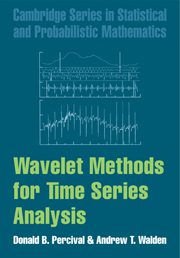Book contents
- Frontmatter
- Contents
- Preface
- Conventions and Notation
- 1 Introduction to Wavelets
- 2 Review of Fourier Theory and Filters
- 3 Orthonormal Transforms of Time Series
- 4 The Discrete Wavelet Transform
- 5 The Maximal Overlap Discrete WaveletTransform
- 6 The Discrete Wavelet Packet Transform
- 7 Random Variables and StochasticProcesses
- 8 The Wavelet Variance
- 9 Analysis and Synthesis of Long MemoryProcesses
- 10 Wavelet-Based Signal Estimation
- 11 Wavelet Analysis of Finite EnergySignals
- Appendix. Answers to Embedded Exercises
- References
- Author Index
- Subject Index
3 - Orthonormal Transforms of Time Series
Published online by Cambridge University Press: 05 December 2013
- Frontmatter
- Contents
- Preface
- Conventions and Notation
- 1 Introduction to Wavelets
- 2 Review of Fourier Theory and Filters
- 3 Orthonormal Transforms of Time Series
- 4 The Discrete Wavelet Transform
- 5 The Maximal Overlap Discrete WaveletTransform
- 6 The Discrete Wavelet Packet Transform
- 7 Random Variables and StochasticProcesses
- 8 The Wavelet Variance
- 9 Analysis and Synthesis of Long MemoryProcesses
- 10 Wavelet-Based Signal Estimation
- 11 Wavelet Analysis of Finite EnergySignals
- Appendix. Answers to Embedded Exercises
- References
- Author Index
- Subject Index
Summary
Introduction
The wavelet analysis of a time series can be defined in terms of an orthonormal transform, so here we briefly review the key ideas behind such transforms. We first review the basic theory for orthonormal transforms in Section 3.1. Section 3.2 discusses the important projection theorem, while 3.3 considers complex-valued transforms. Prior to introducing the discrete wavelet transform (DWT) in Chapter 4, we discuss the orthonormal discrete Fourier transform (ODFT) in Section 3.4 because it parallels and contrasts the DWT in a number of interesting ways. We summarize the key points of this chapter in Section 3.5 - readers who are already comfortable with orthonormal transforms can read this section simply to become familiar with our notation and conventions.
Basic Theory for Orthonormal Transforms
Orthonormal transforms are of interest because they can be used to re-express a time series in such a way that we can easily reconstruct the series from its transform. In a loose sense, the ‘information’ in the transform is thus equivalent to the ‘information’ in the original series; to put it another way, the series and its transform can be considered to be two representations of the same mathematical entity. Orthonormal transforms can be used to re-express a series in a standardized form (e.g., a Fourier series) for further manipulation, to reduce a series to a few values summarizing its salient features (compression), and to analyze a series to search for particular patterns of interest (e.g., analysis of variance).
- Type
- Chapter
- Information
- Wavelet Methods for Time Series Analysis , pp. 41 - 55Publisher: Cambridge University PressPrint publication year: 2000
- 11
- Cited by



